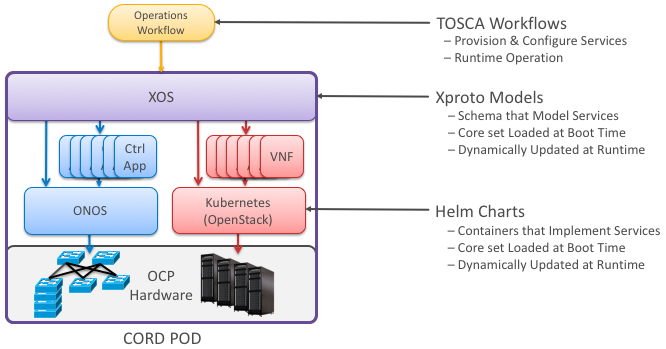Example Use Case
This section gives a brief overview of lifecycle management in CORD, illustrating the role XOS plays in operationalizing a system built from a collection of disaggregated services.

As depicted in this diagram, CORD is built from a collection of SDN Control Apps running on ONOS, plus a collection of VNFs running in OpenStack VMs and/or Kubernetes containers. Operationalizing these components involves the following three layers:
Installation (Helm): Installing CORD means installing a collection of Docker containers in a Kubernetes cluster. CORD uses Helm to carry out the installation, with the valid configurations defined by a set of
helm-charts. Among the containers deployed by Helm are ones that implement CORD's management plane, including XOS.Operations (TOSCA): A running CORD POD supports multiple Northbound Interfaces (e.g., a GUI and REST API), but CORD typically uses
TOSCAto specify a workflow for configuring and provisioning a running system. A freshly installed CORD POD has a set of control plane and platform level containers running (e.g., XOS, ONOS, OpenStack), but until provisioned usingTOSCA, there are no active services or service graph.Integration (XOS): XOS implements a middle layer that connects the NBI(s) to the backend components. It takes an
xprotomodel schema for all the services that are to be included in CORD as input, and generates the code needed to integrate (on-board) those componets. This includes the TOSCA engine used to process the configuration and provisioning workflows.
The resulting system is dynamic. Bringing up new services involves deploying new helm charts and loading new models into XOS, which in turn triggers an upgrade and restart of the TOSCA engine. Upgrading an existing service is similar: Kubernetes incrermentally rolls out the containers that implement the service (and rollbacks them back if necessarily), and XOS migrates from the old model to the new model (and supports both old and new APIs during the transition period).